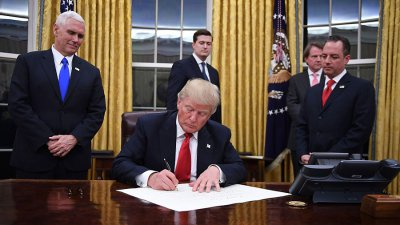Editorial: President Trump plans to do Healthcare his way

President Donald Trump signs an executive order as Vice President Mike Pence and Chief of Staff Reince Priebus look on at the White House in Washington, DC on January 20, 2017. (Photo: JIM WATSON/AFP/Getty Images)
He has only been President for a few hours and President Donald Trump is already signing executive orders with a goal of repealing the Affordable Care Act (ACA). This single reform act could negatively affect more than 20 million people who currently benefit from this law. Trump’s administration claims that they will “broaden healthcare access, make healthcare more affordable and improve the quality of the care available to all Americans.”
According to Republican legislators “Obamacare is a complete and total disaster.” They may find it difficult to improve the existing law, but they have not offered a suitable replacement. Though not perfect, and few laws are, Obamacare has had positive results by enabling many Americans who previously lacked access to healthcare because of financial or previous health conditions.
Studies conducted by the National Center for Health Statistics show that in 2013, 44.8 million persons of all ages (14.4%) were uninsured at the time of interview, 55.4 million (17.8%) had been uninsured for at least part of the year prior to interview, and 33.4 million (10.7%) had been uninsured for more than a year at the time of interview. The percentage of persons uninsured for at least part of the year was 17.8% which totals to 55.4 million people. Still, advancements made by the ACA have made accessibility and quality of Healthcare attainable for many previously disenfranchised American citizens. The U.S. Department of Health and Human Services reports the country has seen the largest reduction in the uninsured in four decades. Since the law was passed, the price of Healthcare has risen at the slowest rate in 50 years. To date, 28 states have expanded Medicaid under the ACA. A Commonwealth Survey shows 68% of people insured through Obamacare have used their coverage to visit a doctor, hospital or other Healthcare provider, pay for prescription drugs.
The ACA has long been a topic of debate. Since its inception, the law has been labeled as “controversial” and favored primarily amongst Democrats and left-leaning Independents. According to a study conducted regarding the law, it has a 51% favorability average amongst all groups. The law shows a 77% favorability amongst Democrats and Democrat-leaning independents, while only reaching 26% for Republicans and Republican-leaning Independents.
Reasons for differing views of the Act are plentiful, but the likely leading reasons might be very simple. It is more favorable to those who benefit from it, and unfavorable to those who don’t. Citizens whose income is greater than 400% of the Federal Poverty line have shown to have a 40% negative impact of the ACA, when only 23% of people who have an income lower than 250% of the Federal Poverty Line have been negatively impacted by the law.
Despite these divisions in belief, some form of Health Care Reform may be a necessity as prices surge to ridiculous numbers. President Trump claims that his new plan will be bigger and better and will allow everyone to have insurance at a reasonable price. In a recent press conference the President stated that the people are “going to be very proud of what we put forth having to do with health care.” As many people currently benefit from the law, one can only hope that the President’s new law will indeed be better than the already successful one.

